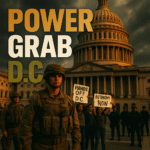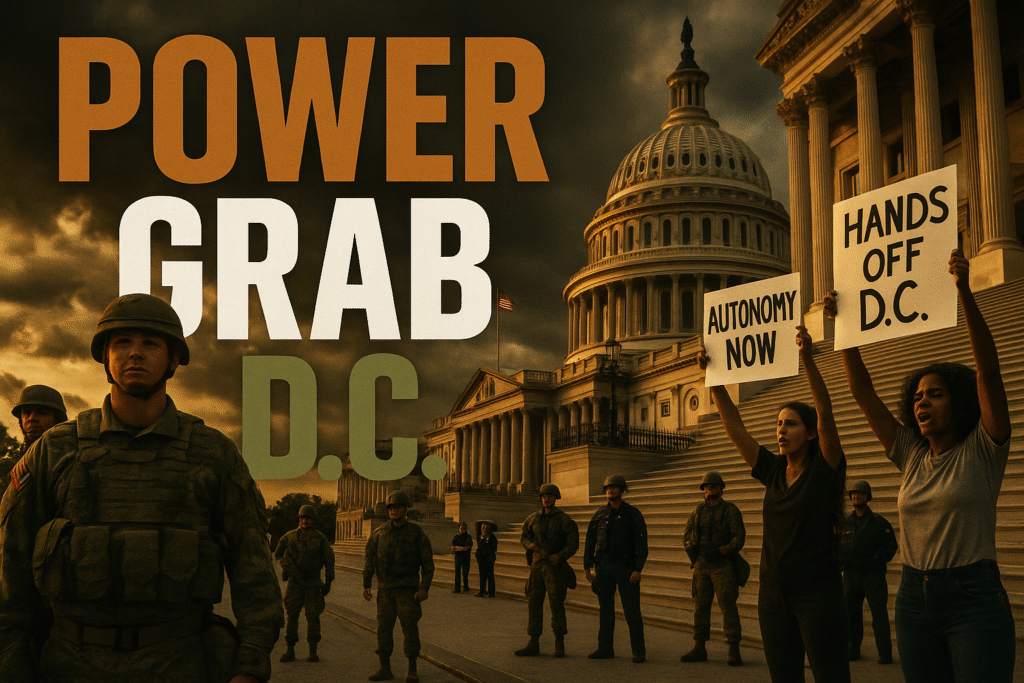

Trump’s D.C. Takeover: A Political Gambit
By Darius Spearman (africanelements)
Support African Elements at patreon.com/africanelements and hear recent news in a single playlist. Additionally, you can gain early access to ad-free video content.
Federal Intervention in D.C.
President Donald Trump recently declared a public safety emergency in Washington, D.C. He announced his administration would take over the city’s police department. Furthermore, he plans to deploy the National Guard to combat crime and remove homeless encampments (washingtonpost.com). On August 11, 2025, President Trump stated he was taking over Washington’s police department and activating 800 members of the National Guard to reduce crime (washingtonpost.com). Flanked by his attorney general, defense secretary, and FBI director, the president stated he was declaring a public safety emergency. He also stated he would remove homeless encampments (washingtonpost.com).
The White House had previously announced an increased presence of federal law enforcement in D.C. to combat crime. Press secretary Karoline Leavitt stated, “there will be no safe harbor for violent criminals in D.C.” (apnews.com). The U.S. Marshals Service had already assigned over 120 officers and agents to assist in Washington (sandiegouniontribune.com). This intervention came after an image surfaced of a federal staffer injured in an attempted carjacking (washingtonpost.com). The idea of federal troops patrolling D.C. invoked memories of 2020. At that time, Trump called in federal authorities, including the National Guard, to respond to protests (cnn.com).
Crime Statistics and Contradictions
D.C. officials and crime statistics indicate that crime rates in the city are already falling. This contradicts President Trump’s justification for federal intervention. City officials stressed that crime was already falling in the nation’s capital (washingtonpost.com). D.C. crime data shows violent crime is down 26% compared to last year (knkx.org). Mayor Muriel Bowser noted that violent crime in Washington has decreased since a rise in 2023 (sandiegouniontribune.com). Mayor Bowser stated that if the president’s priority is to show force, he can do so, but “it won’t be because there’s a spike in crime” (knkx.org).
Violent crime in D.C. hit a 30-year low (justice.gov). Overall violent crime was down 35% and on track to be at its lowest level since the Metropolitan Police Department (MPD) began reporting roughly 20 years ago (justice.gov). Carjackings involving firearms were down 55% (justice.gov). The U.S. Attorney’s Office for D.C. dedicated specific prosecutors and launched daily reviews of firearms arrests to support federal prosecution of gun violence drivers (justice.gov). One expert stated that it is “not clear that DC is, in fact, undergoing a public safety crisis” (cnn.com).
D.C. Crime Rate Changes (2023-2024)
Legality and Challenges of Federal Control
The legality and effectiveness of a federal takeover of D.C.’s police department are being questioned by city officials and legal experts. Deploying federal law enforcement assets and the National Guard falls within presidential authority (adn.com). However, taking over the police department would require a declaration of emergency and would likely be challenged in court (adn.com). Trump has suggested that the rule of Washington could be returned to federal authorities. This would require a repeal of the Home Rule Act of 1973 in Congress (apnews.com). His lawyers are examining this step, but it could face significant opposition (apnews.com).
Mayor Bowser questioned the effectiveness of using the Guard to enforce city laws (sandiegouniontribune.com). She suggested that the federal government could be more helpful by funding more prosecutors or filling judicial vacancies (sandiegouniontribune.com). As of August 10, 2025, the National Guard had not yet been activated, despite Trump’s threats (knkx.org). The concept of the federal government “taking over” a city police department, as described, involves the President placing local police under federal control and deploying federal assets like the National Guard (washingtonpost.com). The legal and practical mechanisms for such a direct takeover of a local police department are not fully detailed, nor are historical precedents.
Defining Public Safety and Federal Control
The term “public safety emergency” is used but not clearly defined in the context of federal intervention. President Trump declared such an emergency in D.C. as a basis for federal action (washingtonpost.com). The specific legal definition of a “public safety emergency” and its implications for federal intervention are not provided in the available information. However, it serves as the stated justification for the President’s actions. The concept of the federal government “taking over” a city police department involves the President placing local police under federal control and deploying federal assets like the National Guard (washingtonpost.com). The legal and practical mechanisms required for such a takeover, and any historical precedents, are not detailed.
The distinctions between the D.C. National Guard and out-of-state Guard units, their command structures, or specific authorized duties are not explicitly detailed. However, the deployment of the D.C. National Guard by the President is mentioned (washingtonpost.com). The Home Rule Act of 1973 is referenced as a legal barrier to federal control over D.C. (apnews.com). However, no background or explanation is provided about what the Act entails or how it governs D.C.’s autonomy. The specific types of crimes included in the cited crime data, the exact sources of the data, or how crime trends are typically measured and reported in D.C. are not detailed, beyond the general mention of violent crime decreases.
Key Terms in D.C. Federal Intervention
A declaration made by President Trump to justify federal intervention in Washington, D.C. The specific legal definition and implications for federal action are not detailed in the provided information.
The President's stated intention to place the local police department under federal control and deploy federal assets like the National Guard. The legal and practical mechanisms for this action are not fully explained.
A federal law mentioned as a potential legal barrier to direct federal control over D.C.'s governance. Its specific provisions regarding D.C.'s autonomy are not detailed.
Unanswered Questions and Coordination
The effectiveness of the National Guard deployment in reducing crime is not assessed. It is also not specified if troops are unarmed or positioned in low-crime or tourist areas. One source notes that it is “not clear that DC is, in fact, undergoing a public safety crisis” (cnn.com). The specific policies or actions to be taken to remove homeless encampments are not detailed. The legal and humanitarian considerations involved are also not discussed. The provided information states that the administration would be removing homeless encampments (washingtonpost.com).
How federal law enforcement, the National Guard, and local police will coordinate their efforts is not detailed. The specific authority each will have under the new arrangement is also not specified. However, the information mentions cross-staffed investigative teams and daily reviews involving federal and local law enforcement. In early 2022, law enforcement partners formed investigative teams cross-staffed with federal law enforcement agents and MPD officers (justice.gov). In April 2022, a daily review was launched by the U.S. Attorney's Office, federal law enforcement partners, and MPD of every firearms arrest in D.C. (justice.gov). The likely legal challenges to the federal takeover or expanded federal role are not discussed, nor is a timeline or process for such challenges.
Political Motivations and Impact
The federal government is intervening despite falling crime rates. President Trump cited an image of an injured federal staffer as a catalyst (washingtonpost.com). City officials stressed that crime was already falling in the nation's capital (washingtonpost.com). One expert noted that it is “not clear that DC is, in fact, undergoing a public safety crisis” (cnn.com). The political motivations are implied through the President's statements and the timing of the intervention. The provided information does not discuss how these federal actions will affect daily life for Washington, D.C. residents, especially marginalized communities.
It is not indicated whether the federal government will provide additional funding for prosecutors, courts, or social services, as suggested by city officials. The focus of the reported actions appears to be solely on law enforcement presence and control. The duration of the National Guard and federal law enforcement deployment is not specified. The criteria for their withdrawal are also not outlined. This intervention raises questions about the balance of power between federal and local authorities. It also highlights the ongoing debate about the most effective strategies for addressing crime and social issues in urban areas.
Political Context of D.C. Intervention
The federal intervention occurs even as D.C. officials report significant decreases in violent crime rates, raising questions about the true motivation.
President Trump cited an image of an injured federal staffer from an attempted carjacking as a key reason for the intervention.
Experts suggest that D.C. may not be experiencing a public safety crisis that warrants such a federal takeover.
ABOUT THE AUTHOR
Darius Spearman has been a professor of Black Studies at San Diego City College since 2007. He is the author of several books, including Between The Color Lines: A History of African Americans on the California Frontier Through 1890. You can visit Darius online at africanelements.org.
